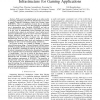ICDCS
2012
IEEE
12 years 4 months ago
2012
IEEE
—With users increasingly focused on an online world, an emerging challenge for the network infrastructure is the need to support Massively Multiplayer Online Role Playing Games (...
INFOCOM
2011
IEEE
13 years 5 months ago
2011
IEEE
—Opportunistic ad-hoc communication enables portable devices such as smartphones to effectively exchange information, taking advantage of their mobility and locality. The nature ...
ASUNAM
2010
IEEE
13 years 5 months ago
2010
IEEE
Social network analysis has recently gained a lot of interest because of the advent and the increasing popularity of social media, such as blogs, social networks, microblogging, o...
VLDB
2000
ACM
14 years 5 months ago
2000
ACM
Information Dissemination applications are gaining increasing popularity due to dramatic improvements in communications bandwidth and ubiquity. The sheer volume of data available ...
DEXAW
1999
IEEE
14 years 6 months ago
1999
IEEE
We propose an information push model information dissemination to mobile users, called dynamic channel model. It is a set of extensions to the conceptual models developed for info...
ISADS
2003
IEEE
14 years 7 months ago
2003
IEEE
In many ubiquitous computing (ubicomp) applications, such as smart classrooms, hospitals, construction sites, stadiums, shopping malls, emergency services, law enforcement, conven...
MIDDLEWARE
2004
Springer
14 years 7 months ago
2004
Springer
This paper explores integrating self-tuning updates and sequential consistency to enable transparent replication of large-scale information dissemination services. We focus our at...
HPDC
2005
IEEE
14 years 7 months ago
2005
IEEE
Information dissemination is a fundamental and frequently occuring problem in large, dynamic, distributed systems. We propose a novel approach to this problem, interest-aware info...
ESCIENCE
2006
IEEE
14 years 8 months ago
2006
IEEE
Effective scheduling in large-scale computational grids is challenging because it requires tracking the dynamic state of the large number of distributed resources that comprise th...
ICDCSW
2007
IEEE
14 years 8 months ago
2007
IEEE
Event dissemination in large scale dynamic systems is typically claimed to be best achieved using decentralized peer-to-peer architectures. The rationale is to have every particip...




